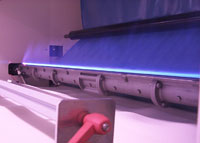High Capacity Flame Treatment Burners
Designed for the treatment of plastic film, foil, textiles, non-woven fibers and in lamination. Constructed so all irregularities and breaks in the flame are eliminated.
This is the #1 burner used in flame laminating and flame treating film. It is a portless designed ribbon, which produces no breaks in the flame, therefore it provides a continuous flame from end to end. The ribbons are stacked in 5 segments to provide maximum energy transference to the substrate.
The Selas High Capacity Flame Treatment Burner is designed for the treatment of plastic film, foil, textiles, non-woven fibers and in lamination. They are constructed in a manner that eliminates all irregularities and breaks in the flame, found in most ported burners of this type.
Ignition is immediate over the entire flame space with a vast range of turndown, and immediate shutoff is assured without flashback. They are fabricated of 1” to 12” sections which are bolted together to the desired burner length, with a continuous port-free ribbon design installed to assure a non-striated (lines) and uninterrupted flame condition along the entire length. They can be operated in conjunction with any type of gas and air-gas mixing system. Balanced blue flame ratings per 12” section are set at a maximum of 60,000 BTU. Precision engineered for exacting requirements, Selas High Capacity Flame Treatment Burners offer long and trouble free service.
 By combining the end feed sections with bottom feed sections, in various configurations, continuous burners up to 42 feet in length have been built. By combining a supply manifold with distributed bottom feed castings, extremely even flame lengths can be obtained with maximum rigidity of the burner.
By combining the end feed sections with bottom feed sections, in various configurations, continuous burners up to 42 feet in length have been built. By combining a supply manifold with distributed bottom feed castings, extremely even flame lengths can be obtained with maximum rigidity of the burner.
A water jacket is available for this flame treatment burner, for the purpose of keeping the burner perfectly straight during production runs. When tolerances for treating are extremely tight and the flame needs to be as parallel to the product as possible, the water jacket allows the excess heat from the burner to be “washed away”. By running chilled water through the water jacket, the burner is capable of staying within tolerances not previously achieved with the burner alone.







